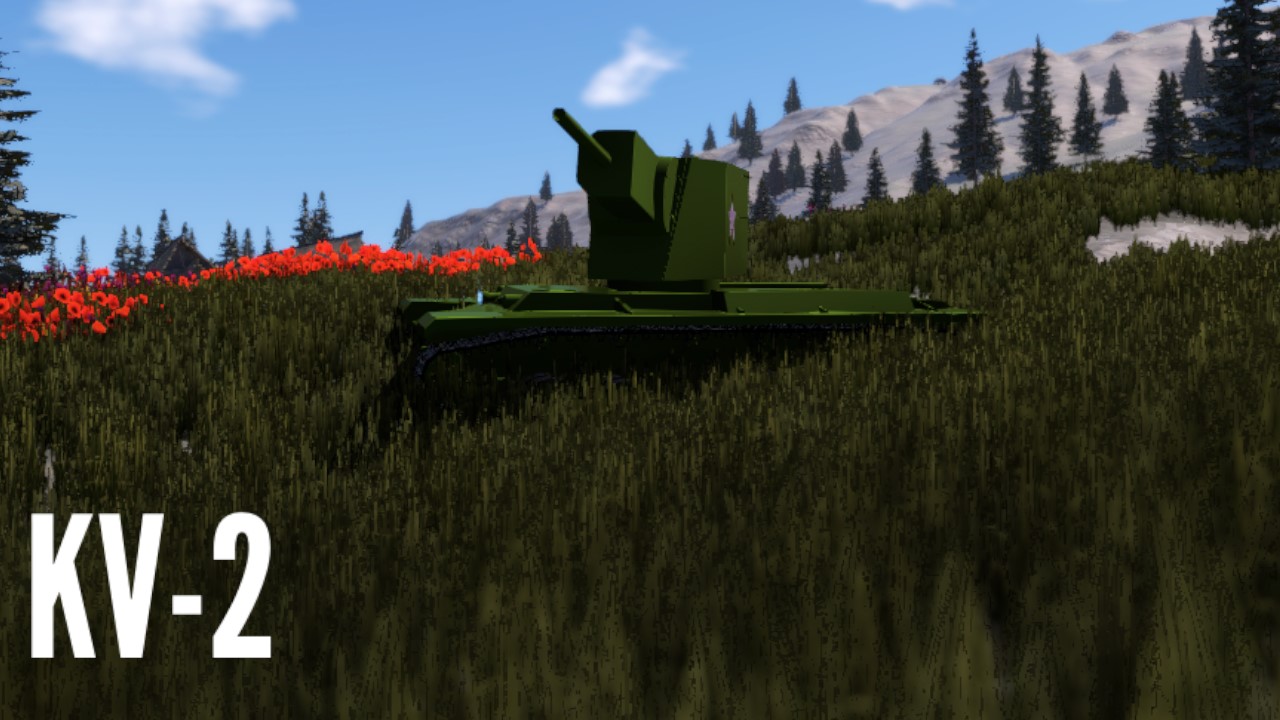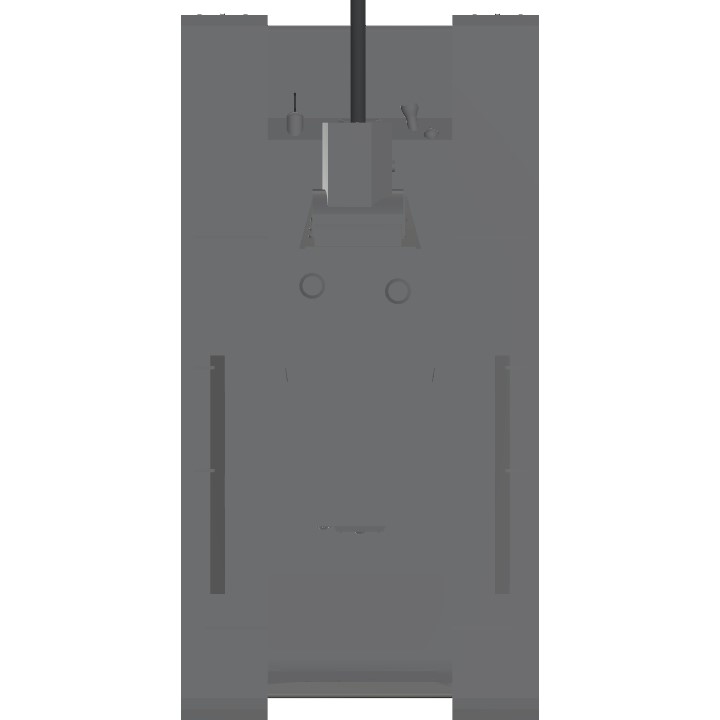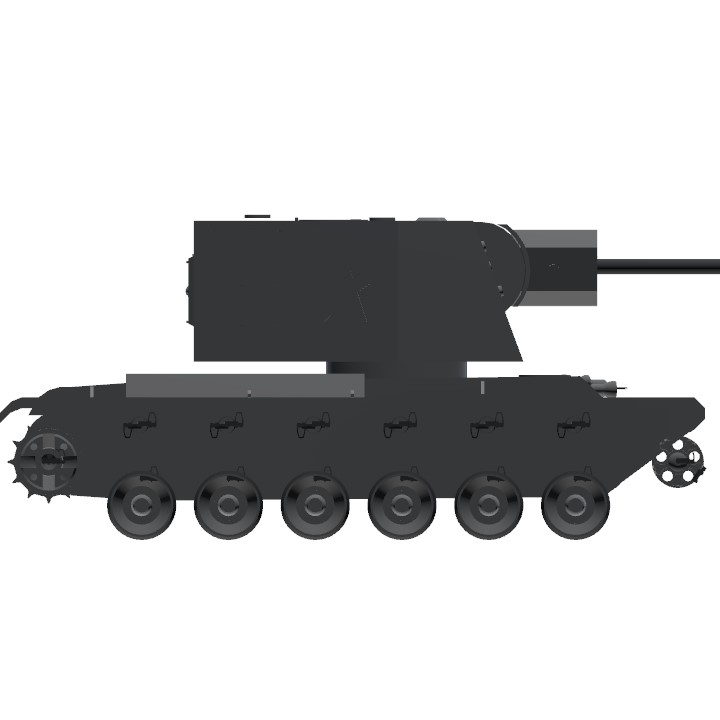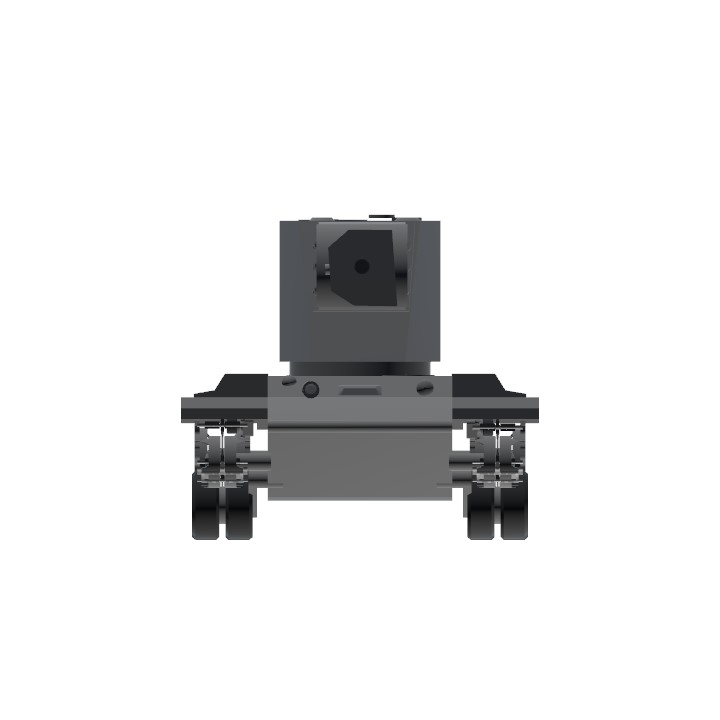About
A heavy 52 ton assault tank with the M-10 152 mm howitzer, the KV-2 was produced at the same time as the KV-1. Due to the size of its heavy turret and gun, the KV-2 was slower and had a much higher profile than the KV-1. Those captured and used by the German Army were known as (Sturm)Panzerkampfwagen KW-II 754(r).[24] Few were produced due to its combat ineffectiveness, mainly the decreased speed due to the weight of the new gun and turret. Due to an increase in turret weight from the expanded dimensions and a heavier gun, the turret traverse mechanism could work only on level ground.
The North-West front headquarters and the Commander of the Seventh Army, Kiril Meretskov, made forceful requests for a bunker-busting heavy tank. Several projects were then undertaken. In one of their last projects before disbandment, the OKMO team revived the T-100 hull and mounted a B-13 130 mm (5.12 in) naval gun, designating it the SU-100Y. However, this was rejected because of the army’s lack of barrels and naval semi-armor piercing rounds, at a time when the Soviet Navy was beginning a massive expansion in order to create a more powerful, ocean-going fleet. Somewhat more pragmatically, Zhozef Kotin’s team, at the Kirov Plant in Leningrad, developed two designs based on the already battle-proven KV chassis, which made more sense in terms of streamlining production costs. There was an initial attempt to mount a 152 mm (5.98 in) BR-2 and a 203 mm (8 in) B-4 howitzer on a lengthened KV hull, but this was never completed.
The third design was the design which was chosen. Completed in two weeks, it had a 152 mm (5.98 in) howitzer with two DT machine guns mounted on an unmodified KV chassis. It was accepted for production and designated the KV-2. First trials were conducted on 10th February, 1940 and shortly after, two prototypes were sent to the front on the Karelian Isthmus. However, there is some debate as to whether these prototypes saw combat. Recent evidence suggests that Meretskov’s and others’ reports on the excellent results achieved by the KV-2 against fortified positions and pillboxes referred to tests conducted against already captured positions.
The KV-2 had one of the most unique silhouettes of WWII. The hull was no different to that of a KV-1, but in order to fit the 152 mm (5.98 in) L20 howitzer, a box shaped, 12.9 tonne turret was mounted. This now made the vehicle stand 4.9 m (16 ft) tall, compared to the 3.9 m (12.8 ft) height of the KV-1. However, the high profile of the KV-2’s turret was compensated by its immense armor – 110 mm (4.33 in) frontal armor and 75 mm (2.95 in) side armor.
In October 1941, KV-2 production was halted as Soviet factories relocated and were moved eastwards to avoid German capture.
Designation of the two models varies between sources and can be confusing. The earlier model of the KV-2 had a turret with a sloped front with rivets and only featured one DT machine gun in a hull mount. It weighed 53.8 tons, and was the lesser produced model. In German sources, this variant is referred to as the KW-II. This model is sometimes erroneously called the KV-2 M1939 or KV-2 M1940. The turret is often wrongly called the MT-1, but that is the designation of the gun mount, not the turret. Sometimes the MT-10 designation is also wrongly used for the turret, and this seems like a mix of the mount name and the gun name (MT-1 + M-10). The turret was actually simply called “big turret” (??????? ??????).
The later variant of the KV-2 featured the more common and boxy turret, featuring a second DT machine gun in a rear mount, and an improved rear turret hatch that made resupplying ammunition easier. The armor was kept the same, but thanks to the removal of the angled turret front, it had a much roomier crew turret, meaning that working conditions were better for the crew, especially the loaders. In German sources, this variant is referred to as the KW-2B or KW-IIB. It is sometimes wrongly designated as the KV-2A, KV-2 M1940, KV-2 M1941 or KV-2B. The turret is often erroneously called the MT-2, seemingly as a progression over the wrong MT-1 designation of the previous turret. The turret was also simply called “reduced turret” (?????????? ?????).
Very few early production models were fitted with the 122 mm (4.8 in) 1938 L/22.7 howitzer fitted to the earlier turret. The number produced is unknown, but were very limited before they were upgunned with the 152 mm (5.98 in) howitzer.
An unknown number of KV-2s were captured by the Wehrmacht. They were sent to Berlin for tests before they were fitted with a new commander’s cupola and sent back to the front line. These were designated (Sturm)Panzerkampfwagen KV-II 754(r) and were often used for artillery observation due to their height.
Perhaps the most interesting variant was a KV-2 armed with a 107 mm (4.21 in) gun. This was during a time when the superheavy tank concept was still being considered by Soviet leadership. There were no plans to serially produce a KV-2 with a 107 mm gun. Instead, just before the Siege of Leningrad, a KV-2 with a 107 mm gun was made and sent for fire testing in March, 1941. The 107 mm gun was going to be mounted on vehicles such as the KV-3, KV-4, and KV-5, but none of these projects left the drawing board as a result of the Siege of Leningrad. All 107 mm guns were destroyed and work on superheavy tanks was stopped.
Due to its size and armored strength, it was nicknamed “Dreadnought” by its six man crews. The KV-2 first saw service in the Winter War as a prototype, as did many other vehicles. However, they were too late to test their might against the more fortified Finnish defenses, as they had already been overrun. Despite this, they still destroyed some remaining enemy bunkers and AT guns. Finnish AT guns were ill-prepared for the KV-2’s strong armor, and even reportedly stopped firing after three non-penetrations.
In the opening years of WWII, when the KV-2 operated in vast numbers, it was virtually invulnerable to direct fire from all but high velocity weapons at horrifically close-range. The best the enemy could hope to was force the KV-2’s crew to abandon the vehicle by disabling it, such as by hitting its tracks and wheels, but this did not always go to plan. A clear example of this was in June 1941, near Raseiniai. Roughly 20 KV tanks of the Soviet 3rd Mechanized Corps met the assault of the 6th Panzer Division, with approximately 100 vehicles. Another vehicle, probably a KV-2 tank, managed to hold off the German advance for a full day while being pummeled by a variety of antitank weapons, until finally the tank ran out of ammunition and was finally knocked out.
Having said this, the KV-2 paid a high price for its immense gun and vast armor. Its mobility between engagements and during battle was heavily restricted by many of the initial gear and transmission problems that the KV-1 faced. This situation was made even worse by the fact that the vehicle now weighed 53.8-57.9 tonnes depending on the model, as well as by using the unimproved 500 bhp V-2 diesel engine.
The road speed of a KV-2 was no more than 25 km/h (15.5 mph) and it only reached a mere 12 km/h (7.5 mph) off-road, making it a very slow moving vehicle. It was also prone to having trouble traversing the heavy turret if not on relatively flat ground. These problems all limited the flexibility of the KV-2 combat, but nevertheless, it was still a formidable opponent if dug into a strategic position. However, it lacked speed and mobility – two traits shown to be massively important in the opening years of the war.
The worst problem for the KV-2 was by far its unreliability. The gearbox would often break easily, and the immense recoil of the gun meant that the small turret ring could jam, or the engine or gearbox could suffer severe damage. The majority of KV-2 losses in 1941 were due to breakdowns or lack of fuel which forced them to be abandoned. The 41st Tank Division lost two thirds of its 33 KV-2s, but only five were as a result of enemy action – usually landmines, as there were few insufficient AT guns or enemy tanks capable of knocking out a KV-2, and as it was used as a breakthrough tank, the KV-2 would often be the first victim of mines.
Despite this, KV tanks came as a nasty shock to German invaders due to their resilience. They had no comparable tanks in strength, and few AT guns that could destroy them.
Marshal Rokossovsky later recalled in his memoirs, A Soldier’s Duty:
“They withstood the fire of every type of gun that the German tanks were armed with. But what a sight they were returning from combat. Their armor all pock-marked all over and sometimes even their barrels were pierced.”
Similarly, the experience of the 1st Panzer Division on 23rd June, 1941 in Lithuania proves just how resilient the KV-2 could be. Here is a record of the engagement:
“Our companies opened fire from 700 m (765 yd). We got closer and closer… Soon we were only about 50-100 m (55-110 yd) from each other. A fantastic engagement opened up – without any German progress. The Soviet tanks continued their advance and our armor-piercing projectiles simply bounced off. The Soviet tanks withstood point-blank fire from both our 50 mm (1.97 in) and 75 mm (2.95 in) guns. A KV-2 was hit more than 70 times and not a single round penetrated. A very few Soviet tanks were immobilized and eventually destroyed as we managed to shoot at their tracks, and then brought up artillery to hammer them at close range. It was then attacked at close range with satchel charges.
How to use?
Yaw: Turret Rotation
If you wanna change the speed, go to "sum(Yaw * 0.[CHANGE_NUMBER])
VTOL: Tank tracks height elevation
Trim: Turret elevation
Weaponary
- M-10 152mm Howitzer
About: By the early 1930s the Red Army (RKKA) started to look for a replacement for the 152-mm howitzer M1909 and the 152-mm howitzer M1910. Those pieces, developed before World War I, had unsprung fixed trail carriages and short barrels, which meant poor mobility, insufficient elevation and traverse angles and short range. Although both pieces were eventually modernized, resulting in the 152-mm howitzer M1909/30 and the 152-mm howitzer M1910/37 respectively, these were relatively minor upgrades which brought only limited improvement in some areas and didn't address others. It was clear that a completely new design was needed. However, at that time, the Soviets had little experience in developing modern artillery pieces.
An initial attempt was made to overcome that issue through a collaboration with Germany. Constrained by the limitations of the Treaty of Versailles, Germany was looking for ways to proceed with weapons development and joint projects gave them such an opportunity. Among other weapons supplied by Germans was a heavy howitzer, designated 152-mm howitzer M1931 (NG) in the USSR. Soon the Motovilikha Mechanical Plant (MMZ) was tasked with the production of this gun. However, only eight pieces were completed in 1932–1934 until production was stopped. The design proved to be too complicated for the Soviet industry of the early 1930s, similar to other designs like 122-mm howitzer M1934 or 20-mm and 37-mm autocannons. Also it was considered somewhat heavy at 5,445 kg in travelling configuration. But these early failures gave Soviet developers some valuable experience.
M-10 in Hämeenlinna artillery museum, Finland.
In 1937, F. F. Petrov and his design team at the Plant No.172 (another name for Motovilikha Plant) started work on a new design, the M-10. Technical papers were submitted to the Artillery Directorate on 1 August 1937 and on 2 November the first prototype was completed. Ground trials (19–25 October 1938) featured two pieces: No. 302 (L/25 barrel with constant rifling) and No. 303 (L/20 barrel with progressive rifling). The No. 303 was found to be superior. The trials also revealed numerous defects in the gun construction: the howitzer suffered from insufficient upper carriage strength, leaks in the recoil buffer, unreliable suspension etc. For army tests early in 1939, an improved design with a longer barrel was presented. Another series of army tests followed from 22 December 1939 to 10 January 1940, but even before it started—on 29 September 1939—the gun was adopted as 152 mm divisional howitzer model 1938. Later, the word divisional was removed from the designation.
Amount: 100
- DT Machine Gun
About: The Degtyaryov machine gun or DP-27/DP-28 is a light machine gun firing the 7.62×54mmR cartridge that was primarily used by the Soviet Union, with service trials starting in 1927, followed by general deployment in 1928
Amount: 1000
Specifications
Spotlights
- B1 1.7 years ago
General Characteristics
- Created On Windows
- Wingspan 13.7ft (4.2m)
- Length 27.2ft (8.3m)
- Height 11.0ft (3.3m)
- Empty Weight 52,039lbs (23,604kg)
- Loaded Weight 53,810lbs (24,407kg)
Performance
- Wing Loading N/A
- Wing Area 0.0ft2 (0.0m2)
- Drag Points 7741
Parts
- Number of Parts 143
- Control Surfaces 0
- Performance Cost 402
Required Mods
-
Tracks 2
by MOPCKOE_DNISHE
Version 0.84 (11/1/2021 2:11:26 PM)
View Mod Page




